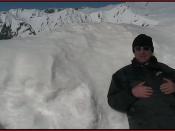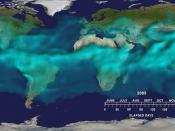Our air holds a mixture of many gases, liquid droplets and solid particles, but 99% of our air is made up of nitrogen and oxygen. The life process of all plants and animals depend on nitrogen and carbon dioxide. Plants produce oxygen by photosynthesis. The key to photosynthesis is the ability of chlorophyll, the green pigment in plants, to convert sunlight into chemical energy.
In measuring the temperature of the atmosphere we find that there are four levels where the temperature varies greatly. These levels are troposphere, which because of gravity is held closest to the surface of the earth and rises to about ten miles. The atmospheric conditions of the lower troposphere are referred to collectively as weather. As you near the top of the troposphere the temperature decreases to as much as -60 degrees F.
The stratosphere covers about the next forty miles and as you go higher into the stratosphere the temperature again rises.
Above the stratosphere, from about thirty miles to fifty miles is the mesosphere here the temperature again falls, dropping to as little as -140 degrees F.
Above the mesosphere the temperature of the thermosphere varies considerably with solar activity. The thin atmosphere is heated intensely by the suns rays and can reach temperatures to over 1800 degrees F. Ozonosphere and Ionosphere are also divisions in the atmosphere.
Within the ozonosphere lies the ozone layer. Ozone is formed by the dissociation of molecular oxygen and the combining of atomic oxygen with molecular oxygen. This is accomplished with the appropriate ultraviolet (UV) radiation and oxygen at an optimum altitude of about twenty miles.
The ionosphere is made up of electrically charged ions and electrons that are trapped in the earth's magnetic field. These form ionic layers in the upper region of the atmosphere. The ionosphere...



Stick to the topic.
Stick to writing about the atmosphere, don't stray off writing about tornadoes, lightning etc..
And if you're going to talk about lightning get some of the facts straight.
0 out of 0 people found this comment useful.